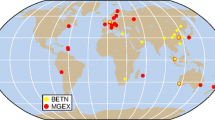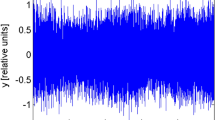Abstract
The clock products of the International Global Navigation Satellite Systems (GNSS) Service (IGS) are used to characterize the timing performance of the GPS satellites. Using 5-min and 30-s observational samples and focusing only on the sub-daily regime, approximate power-law stochastic processes are found. The Block IIA Rb and Cs clocks obey predominantly random walk phase (or white frequency) noise processes. The Rb clocks are up to nearly an order of magnitude more stable and show a flicker phase noise component over intervals shorter than about 100 s. Due to the onboard Time Keeping System in the newer Block IIR and IIR-M satellites, their Rb clocks behave in a more complex way: as an apparent random walk phase process up to about 100 s and then changing to flicker phase up to a few thousand seconds. Superposed on this random background, periodic signals have been detected in all clock types at four harmonic frequencies, n × (2.0029 ± 0.0005) cycles per day (24 h coordinated universal time or UTC), for n = 1, 2, 3, and 4. The equivalent fundamental period is 11.9826 ± 0.0030 h, which surprisingly differs from the reported mean GPS orbital period of 11.9659 ± 0.0007 h by 60 ± 11 s. We cannot account for this apparent discrepancy but note that a clear relationship between the periodic signals and the orbital dynamics is evidenced for some satellites by modulations of the spectral amplitudes with eclipse season. All four harmonics are much smaller for the IIR and IIR-M satellites than for the older blocks. Awareness of the periodic variations can be used to improve the clock modeling, including for interpolation of tabulated IGS products for higher-rate GPS positioning and for predictions in real-time applications. This is especially true for high-accuracy uses, but could also benefit the standard GPS operational products. The observed stochastic properties of each satellite clock type are used to estimate the growth of interpolation and prediction errors with time interval.





Similar content being viewed by others
Explore related subjects
Discover the latest articles, news and stories from top researchers in related subjects.References
Agnew DC, Larson KM (2007) Finding the repeat times of the GPS constellation. GPS Solut 11:71–76. doi: 10.1007/s10291-006-0038-4
Allan DW (1987) Time and frequency (time-domain) characterization, estimation, and prediction of precision clocks and oscillators. IEEE Trans Ultrason Ferroelectr Freq Control 34(6):647–654
Allan DW, Hellwig H (1978) Time deviation and time prediction error for clock specification, characterization, and application. In: Proceedings of the position location and navigation symposium (PLANS), pp 29–36 (BIN: 136)
Barnes JA, Chi AR, Cutler LS, Healey DJ, Leeson DB, McGunigal TE, Mullen JAJ, Smith WL, Sydnor RL, Vessot RFC, Winkler GMR (1971) Characterization of frequency stability. IEEE Trans Instrum Meas IM-20(2)
Baugh RA (1971) Frequency modulation analysis with the hadamard variance. In: Proceedings of the 25th annual frequency control symposium, IEEE, Atlantic City, pp 222–225
Beutler G, Brockmann E, Gurtner W, Hugentobler U, Mervart L, Rothacher M (1994) Extended orbit modeling techniques at the CODE processing center of the international GPS service for geodynamics (IGS): theory and initial results. Manuscripta Geod 19(B7):367–387
Beutler G, Kouba J, Springer T (1995) Combining the orbits of the IGS analysis centers. Bull Geod 69:200–222
Colombo OL (1989) The dynamics of global positioning orbits and the determination of precise ephemerides. J Geophys Res 94:9167–9182
Gendt G, Schmid R (2005) Planned changes to IGS antenna calibrations. IGSMAIL #5189 (http://igscb.jpl.nasa.gov/mail/igsmail/2005/msg00111.html)
GPS ICD-200 (2006) NAVSTAR GPS space segment/navigation user interface specification IS-GPS-200. Interface specification IRN-200D-001, US Air Force GPS Wing, Headquarters, Space and Missile Systems Center
Griffiths J, Ray J (2007) On the accuracy of IGS orbits. Eos Trans AGU 88(52)
Harris FJ (1978) On the use of windows for harmonic analysis with the discrete fourier transform. In: Proceedings of the IEEE, vol 66, pp 51–83
Hernandez-Pajares M, Juan JM, Sanz J, Orus R (2007) Second-order ionospheric term in GPS: implementation and impact on geodetic estimates. J Geophys Res 112. doi:10.1029/2006JB004707
IEEE (1999) Definitions of physical quantities for fundamental frequency and time metrology—random instabilities. Tech Rep 1139, Piscataway, NJ
ITU (1996) Definitions and terminology for synchronization networks. ITU-T recommendation G.810, ITU, Geneva
ITU (2002) Glossary and definitions of time and frequency terms. ITU-R recommendation TF.686-2, ITU, Geneva
Kouba J (2004) Improved relativistic transformations in GPS. GPS Solut 8:170–180
Kouba J, Springer T (2001) New IGS station and satellite clock combination. GPS Solut 4:31–36
McCarthy DD, Petit G (2004) IERS conventions 2003. IERS technical note 32, Verlag des Bundesamts fuer Kartographie und Geodaesie, Frankdfurt am Main
NIST (1990) Characterization of clocks and oscillators. Tech Rep TN-1337, US National Institute of Standards and Technology
Petzinger J, Reith R, Dass T (2002) Enhancements to the GPS block IIR timekeeping system. In: Breakiron L (ed) Proceedings of the 34th annual precise time and time interval systems and applications meeting, US Naval Observatory, Reston, pp 89–107
Phelan J, Dass T, Freed G, Rajan J, D’Agostino J, Epstein M (2005) GPS block IIR clocks in space: current performance and plans for the future. In: Breakiron L (ed) Proceedings of the 37th annual precise time and time interval systems and applications meeting, US Naval Observatory, Vancouver, pp 19–25
Ray JR, Senior KL (2003) IGS/BIPM pilot project: GPS carrier phase for time/frequency transfer and time scale formation. Metrologia 40:S270–S288
Ray JR, Senior KL (2005) Geodetic techniques for time and frequency comparisons using GPS phase and code measurements. Metrologia 42:215–232
Rochat P, Droz F, Mosset P, Barmaverain G, Wang Q, Boving D, Mattioni L, Belloni M (2005) The onboard galileo rubidium and passive maser, status & performance. In: Proceedings of the 2005 IEEE international frequency control symposium and exposition, Vancouver, pp 26–32. doi:10.1109/FREQ.2005.1573898
Schmid R, Steigenberger P, Gendt G, Ge M, Rothacher M (2007) Generation of a consistent absolute phase-center correction model for gps receiver and satellite antennas. J Geod. doi:10.1007/s00190-007-0148-y
Senior K, Koppang P, Ray J (2003) Developing an IGS time scale. IEEE Trans Ultrason Ferroelectr Freq Control 50:585–593
Urschl C, Beutler G, Gurtner W, Hugentobler U, Schaer S (2007) Contribution of SLR tracking data to GNSS orbit determination. Adv Space Res 39:1515–1523
Walter T (1994) Characterizing frequency stability: a continuous power-law model with discrete sampling. IEEE Trans Instrum Meas 43(1):69–79
Wu A (1996) Performance evaluation of the GPS block IIR time keeping system. In: Breakiron L (ed) Proceedings of the 28th annual precise time and time interval applications and planning meeting, US Naval Observatory, Reston, pp 441–453
Zumberge JF, Heflin MB, Jefferson DC, Watkins MM (1997) Precise point positioning for the efficient and robust analysis of GPS data from large networks. J Geophys Res 102:5005–5017
Acknowledgments
The authors gratefully thank Jan Kouba (Natural Resources Canada), Kristine Larson (University of Colorado), and Arthur Dorsey (Lockheed Martin Corp.) for helpful discussions and critiques. The products of the IGS and its analysis centers have been indispensable.
Author information
Authors and Affiliations
Corresponding author
Appendix: Allan deviation
Appendix: Allan deviation
We now give a very brief introduction to the Allan deviation as a measure of frequency instability in clocks, or oscillators. In order to remain brief, several simplifications have been made which the detailed reader will likely want to avoid. For further reading on clock measurement and modeling, we suggest the collection of papers that make up NIST (1990). For a concise mathematical description of the the Allan and Modified Allan deviations consider also Walter (1994).
The voltage output of an oscillator/clock is usually represented as
where V 0 is its nominal peak voltage amplitude, ν 0 is the nominal fundamental frequency, and ϕ denotes the deviations in phase from the nominal frequency; fluctuations in amplitude do not contribute appreciably to the frequency instability of most oscillators and so the amplitude has been considered constant here. The instantaneous frequency may be defined as the derivative (divided by 2π) of the total phase of the sine,
But, because the magnitude of this frequency is generally quite small for most oscillators and in order to avoid the dependence on nominal frequency, we generally define instead the normalized (or fractional) frequency,
where
is the phase expressed in time units.
The phase (or time) of a clock is generally subject to both systematic as well as random fluctuations. Combinations of five common power-law processes, that is processes whose power spectral density vary as powers of their Fourier frequency, are often used to describe the random behavior of most clocks. Table 2 summarizes these common power law processes.
The IEEE has recommended (Barnes et al. 1971) the 2-sample, or Allan variance σ 2 y (τ) (or square-root for Allan deviation) as a time-domain measure of frequency instability, defined as
where 〈·〉 represents infinite time average and
is the average fractional frequency over a specified interval of interest τ. This measure is desirable because it is convergent for the power-law processes shown in Table 2 and because the level and type of power law may be inferred easily by inspecting σ y (τ) over a range of τ.
Because the Allan deviation has the same τ relationship for white-x and flicker-x noises, a Modified Allan deviation statistic was developed which essentially introduces a measurement bandwidth dependence such that these two noises may be differentiated from one another. We neither show the definition of the Modified Allan nor the Hadamard deviation here, but Table 2 shows the relevant τ relationships.
Rights and permissions
About this article
Cite this article
Senior, K.L., Ray, J.R. & Beard, R.L. Characterization of periodic variations in the GPS satellite clocks. GPS Solut 12, 211–225 (2008). https://doi.org/10.1007/s10291-008-0089-9
Received:
Accepted:
Published:
Issue Date:
DOI: https://doi.org/10.1007/s10291-008-0089-9




